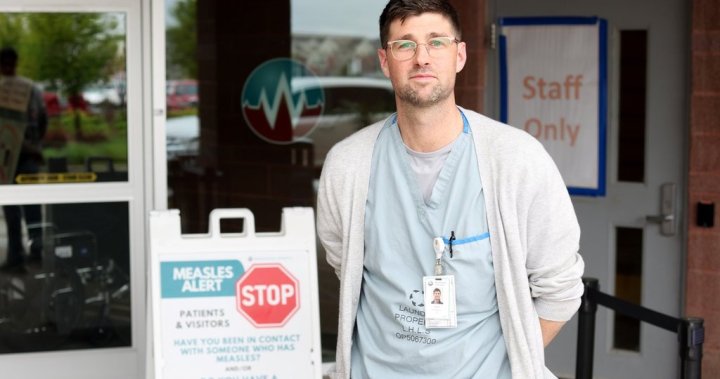Uncategorized
Ontario’s measles outbreak through the eyes of front-line workers

Health-care workers battling measles in southern Ontario say they think about the outbreak from the moment they wake until the moment they sleep.
They say treating and tamping down the surge of a disease most have never seen in their lifetime is constant.
Some have even been infected by patients who unwittingly spread the highly infectious illness while seeking help for early but general symptoms — fevers and coughs are common before the telltale rash appears days later.
Measles has spread to more than 3,000 people in Canada this year. More than 2,000 of those infected are in Ontario.
Here’s a look at caregivers on the front lines of an outbreak that has particularly struck a region south and east of London.
“THE UNLUCKY ONES”
Carly Simpson considers herself one of the “unlucky ones.”
Five days after developing a sore throat, body aches and fever, the nurse practitioner gazed at her reflection in the bathroom mirror, stunned to see red splotches all over her body.
“Oh my gosh this is measles,” Simpson gasped.
She said measles never crossed her mind when she first fell ill mid-March, suspecting a more likely cause was her autoimmune disease, ankylosing spondylitis, which leads to chronic pain and inflammation.
After all, the vast majority of cases had been among the unvaccinated and Simpson said she had been inoculated three times — including a booster in 2015 after a test revealed her previous two shots didn’t lend full immunity.
Simpson said she had been assured at the beginning of the outbreak that three shots would be enough to protect her. She still got sick and was essentially bedridden for days, only mustering enough energy to walk to the bathroom. But she said the rash only lasted a day and never spread to her husband or kids.
“I had a mild case because I’ve been vaccinated,” said Simpson, among five per cent of the outbreak’s cases to involve vaccinated people.
She suspected she was infected by a patient who came to her clinic with virus symptoms a couple of weeks earlier.
Early symptoms can seem like other illnesses until the rash appears, leaving health-care workers who examine them vulnerable to exposure.
“Is this just a common cold? Is it just some viral infection?” she said of the questions that dog caregivers.

Shawn Cowley was unlucky, too. He noticed white spots inside his cheeks in late April, and then a red blotchy rash on his forehead that migrated down his face, and onto his shoulders and arms.

Get weekly health news
Receive the latest medical news and health information delivered to you every Sunday.
“Fortunately for me, because I was fully vaccinated I didn’t get the full brunt of measles,” he said, explaining that the rash otherwise would have covered his whole body. Still, it took about a week for his body to recover from the exhaustion.
Cowley is a key player in measles containment as head of emergency management and preparedness at the local health unit, Southwestern Public Health. His case was traced to his son’s hockey tournament.
He eventually told his colleagues that he contracted measles but noted there is “a stigma” associated with the illness.
Cowley also felt guilty for going to the grocery store and filling up on gas before he was symptomatic, potentially spreading it to others.
“When you find out you do potentially have measles, and the number of people I’ve exposed, understanding how virulent measles is, that’s a really hard thing to deal with personally because you put other people at risk.”
“SLOW BURN”
Dr. Erica Van Daalen calls the outbreak a “slow burn” but one that has required close collaboration among local hospitals to safely treat and isolate measles patients.
The chief of staff at St. Thomas Elgin General Hospital said she might see one to three patients in the emergency department on an average day, and often they are children.
As of late May, three infected pregnant women had delivered babies and 15 kids had been admitted. Those include young patients transferred from hospitals in Woodstock and Tillsonburg, which don’t have pediatric units.
“It’s a lot of one-on-one bedside nursing,” Van Daalen said in an interview earlier this spring. “When the days are busy, it wears on the nurses.”
Less than seven per cent of Ontario’s cases have ended up in hospital. But the logistics of safely admitting a measles patient is like expert-level Tetris.
Masked patients are ushered through back doors to negative pressure rooms that keep contaminated air from escaping into other areas of the hospital and infecting more people. The room is sealed and has a system that filters and exchanges the air.

Exposure risks are avoided as much as possible, even trips to the bathroom, said Sangavi Thangeswaran, a registered nurse and an infection control practitioner at both Alexandra Hospital Ingersoll and Tillsonburg District Memorial Hospital.
“We ask the patient to stay in there. If they need anything like using the washroom, we try to give them commodes or urinals, just to lessen the exposures,” Thangeswaran said.
There are five negative pressure rooms at Woodstock Hospital. When they’re full, patients are assessed in the ambulance garage, said David Lambie, a charge nurse in Woodstock’s emergency department.
It is an extra layer of logistics to navigate, said Lambie, whose hospital has cared for 108 measles patients since January, 55 of them kids.
Once a patient is well enough for discharge, their negative pressure room is left empty for half-an-hour while contaminated air is expunged. Then it’s deep cleaned for the next patient, said Thangeswaran.
She said each of her Oxford County hospitals initially had just one negative pressure room in each emergency department but as cases swelled they created three more.
As of June 12, her team had cared for 14 measles patients in Ingersoll and 64 in Tillsonburg.
“INHERENT CHALLENGE”
Van Daalen, of the hospital in St. Thomas, said deciding whether to discharge a kid sick with measles sometimes keeps her up at night.
“You hesitate to send them home because you’re not quite sure how they’re going to land,” she said.
“There are some later-term consequences for kids who have measles. It’s a very rare complication, but we’ll have to keep our surveillance up.”
Dr. Ninh Tran said he felt like he was approaching burnout in late February.
Ontario’s weekly case count had nearly doubled to 177 over a two-week period ending Feb. 27, with almost half of the overall cases located in his southwestern public health unit.
Pressure was high to trace cases, halt community spread and stop infections. Measles was on his mind every moment of the day and night.
“You could sense a bit of tension and anxiety in all this discussion,” Tran recalled in late May.
“It’s always like a temporary feeling of doubt, fear, anxiety when we see numbers go up and there’s just a lot of things coming right at you,” Tran said of the outbreak’s early days.
“And then you have to step back and say, ‘OK, it’s not going to be helpful if I get stressed because I need to — and other leaders have to — figure out a way to move forward.”
The spread of measles has ebbed and flowed, but Tran noted a steady decline of new cases mid-June.
“While it’s still early to confirm a persistent pattern, the consistency of the decrease does suggest a potential shift in the trajectory of the outbreak,” said Tran.
“We are cautiously encouraged.”

Uncategorized
Blue Jays reinstate Gimenez from injured list

TORONTO – The Toronto Blue Jays reinstated second baseman Andres Gimenez from the 10-day injured list Tuesday and designated infielder Buddy Kennedy for assignment.
Gimenez, a three-time Gold Glove award winner, missed five weeks with a left ankle sprain.
Related Videos
The moves were announced shortly before the Blue Jays opened a three-game series against the visiting Chicago Cubs.
Entering play Tuesday night, Gimenez had five homers, 23 RBIs and a .218 average.

Get daily National news
Get the day’s top news, political, economic, and current affairs headlines, delivered to your inbox once a day.
Kennedy had one hit in two games for the Blue Jays. He also played four games for the Philadelphia Phillies earlier this season.
This report by The Canadian Press was first published Aug. 12, 2025.
© 2025 The Canadian Press
Uncategorized
Man dead, another in custody after stabbing in Toronto’s east end


Around 2:30 p.m., Toronto police said they were called to the area of Woodbine and Duvernet avenues for reports someone had been stabbed inside a neighbouring home.
Source link
Uncategorized
Jays’ Shapiro says he wants to remain with team

TORONTO – Blue Jays president Mark Shapiro declined to comment on contract extension talks Tuesday but said he wants to remain with the club and that team ownership has been “reciprocal in that desire.”
Shapiro, who also serves as chief executive officer, is in the final year of his contract.
“When I think about alternatives, I’ve never been a grass is greener guy,” he said in a pre-game availability. “Twenty-four years in one place in Cleveland and 10 years here now.
Related Videos
“So it’s the appreciation for what I have and the people that I get to work with every day, the city that I work in and the country that I live in, those things are drivers for me to remain here.”
Shapiro, 58, joined the club in 2015 and signed a five-year extension in January 2021.

Get daily National news
Get the day’s top news, political, economic, and current affairs headlines, delivered to your inbox once a day.
He took questions from reporters for about 20 minutes in a rare in-season media session. Shapiro was asked directly whether there had been discussions with team owner Rogers Communications on a new deal.
“Sure, yeah, I mean I think (it’s) not appropriate for me to comment beyond the fact that what I just said is I want to remain here,” Shapiro said. “And I can also say that both (Rogers executive chair) Edward (Rogers) and (Rogers president/CEO) Tony (Staffieri) have been reciprocal in that desire.”
It has been a worst-to-first campaign for Canada’s lone Major League Baseball team. The Blue Jays finished last in the American League East division standings last season but have enjoyed a stellar season in 2025.
Toronto entered Tuesday night’s game against the visiting Chicago Cubs with the best record in the AL at 69-50.
This report by The Canadian Press was first published Aug. 12, 2025.
© 2025 The Canadian Press
-

 Uncategorized2 months ago
Uncategorized2 months agoAccording to Dior Couture, this taboo fashion accessory is back
-

 Uncategorized2 months ago
Uncategorized2 months agoThese ’90s fashion trends are making a comeback in 2017
-

 Uncategorized2 months ago
Uncategorized2 months agoThe old and New Edition cast comes together to perform
-

 Uncategorized2 months ago
Uncategorized2 months agoUber and Lyft are finally available in all of New York State
-

 Uncategorized2 months ago
Uncategorized2 months agoNew Season 8 Walking Dead trailer flashes forward in time
-

 Uncategorized2 months ago
Uncategorized2 months agoMeet Superman’s grandfather in new trailer for Krypton
-

 Uncategorized2 months ago
Uncategorized2 months ago6 Stunning new co-working spaces around the globe
-

 Uncategorized2 months ago
Uncategorized2 months agoThe final 6 ‘Game of Thrones’ episodes might feel like a full season







